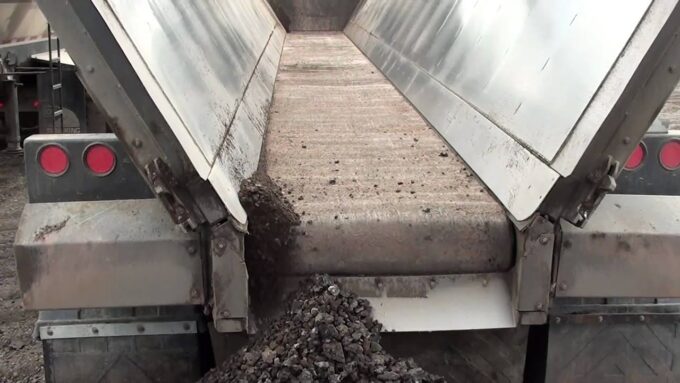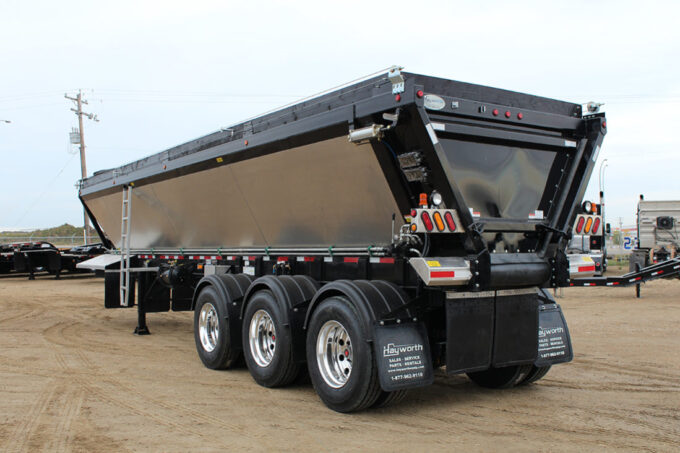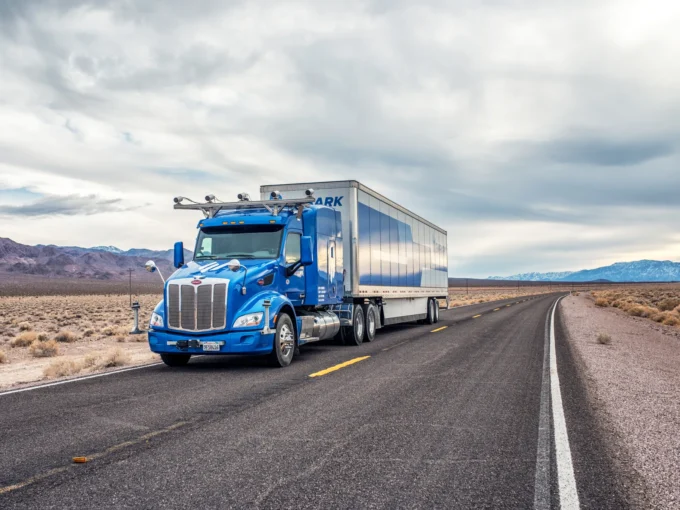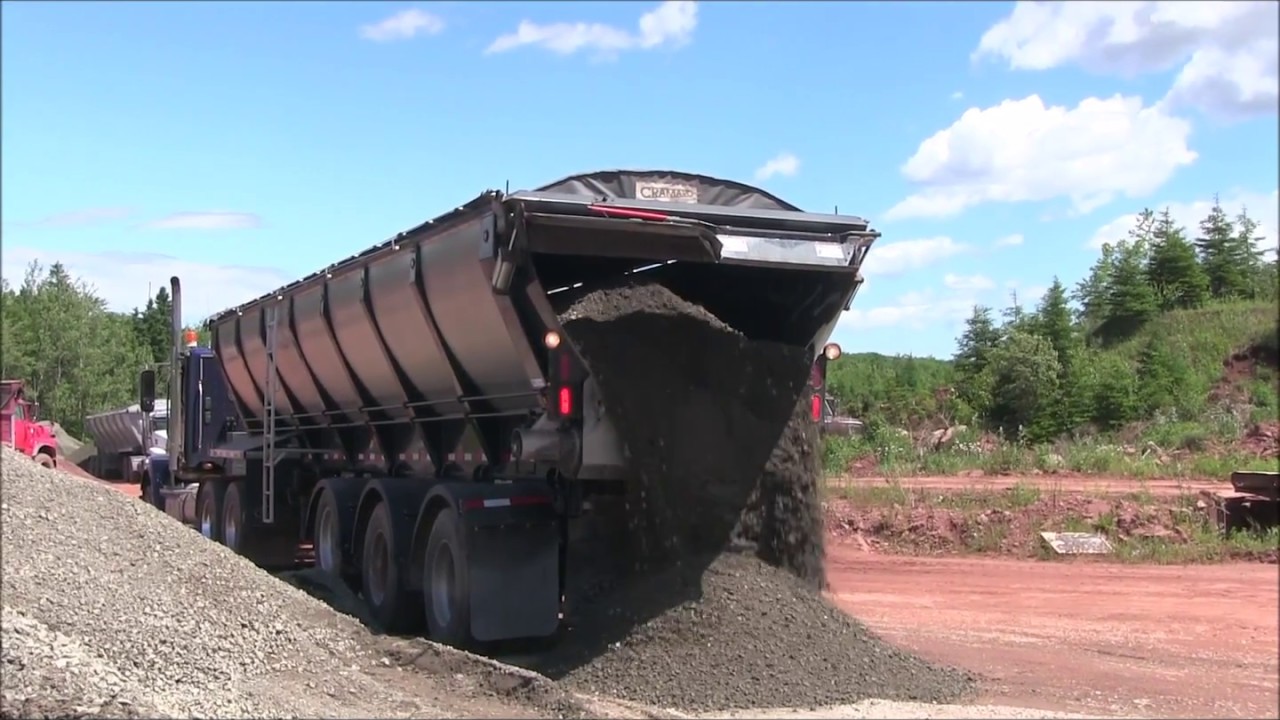Using a live bottom trailer offers many benefits, along with making the process easier for pavers, faster dumping, and, most importantly, a safer option for hauling.
Live-bottom trailers have been used for conveying and delivering asphalt for decades. With the growing use of these trailers, paving contractors continue to see the many advantages of this unloader.
Most live bottom trailers rely on a conveyor belt to push out asphalt. This type of equipment works better than a standard dump truck because there is no need to lift the trailer. Since a live bottom trailer does not need to be lifted, there is a significant decrease in accidents because the risk of rolling is much less than that of a dump truck.
This benefit means a more efficient unload, better control on uneven surfaces, and fewer chances of accidents.
Accomplish More
If you can accomplish more in a day, the better, which is why so many paving contractors trust live bottom trailers.
These haulers allow workers to work faster, make fewer mistakes, and complete more projects than they would otherwise.
Unlike other traditional dumping trailers that need to lift to dump, making it difficult to control the pace and amount of product released, live bottom trailers stay in place, allowing for a more controlled pour. Using this equipment makes the lives of pavers much easier and safer, increasing productivity for everyone.
Improved results from even and quicker unloading is another benefit of using a live bottom trailer. The volume that pavers can pour increases, allowing them to do more with less equipment. Since these trailers are in high demand, the rate of pay for the drivers has increased more than traditional dump truck drivers.
Since these vehicles allow for improved management of unloading materials, there is less time needed for each load, meaning that instead of relying on a dump truck that requires a longer wait and is more unstable, pavers can achieve more in less time.
Not only does using a live bottom trailer take less time, but there are also fewer chances of dealing with interference from cables, power lines, or trees since there is no raising needed.
Using these trailers is ideal for small-scale projects since you can control how much product you need to distribute without waste.
Improved Outcomes

Another advantage of choosing a live bottom trailer over a dump truck is how they handle asphalt. However, you need to ensure it was built by a renowned manufacturer.
Since the conveyor is continually flowing, it lowers the chance of the material separating, clumping, or getting too warm. It can take less than a single rotation of the whole conveyor belt to remove the material from the trailer.
Live bottom trailers improve material consistency since fewer stops are required to access the mixture. With these vehicles, they develop better mat quality because as you add to the mix the same amount can be withdrawn, reducing surges that can cause impact with screed.
Another advantage that live bottoms have over dump trucks is that they retain heat better and longer, which improves the quality of the asphalt delivered and the results of the project.
Reduces Accidents
The growing use of live bottom trailers is not surprising when comparing them and their functions with other dump trucks. Not needing to raise them to deliver materials reduces the chances of accidents. They can access areas that other vehicles cannot, reducing dangerous unloading situations like toppling over from unsteady maneuvers.
These incredibly steady trailers are much less likely to roll over, with an improved balance that does not alter when unloading, making them secure and trusted paving equipment.
The busier a worksite is, the higher the chances of an accident occurring is. Many traditional dump truck drivers are encountering increased rates for insuring their trucks since they have a reputation for being accident-prone, and the insurers are aware of it.
Insurance companies are declining many applications for dump trucks because of their known flaws, which is partly why the growth of live bottom trailers keeps increasing. The trailers have better balance – reducing rollovers, are less likely to tangle in power lines, and offer improved unloading, which increases safety across the board.
Upkeep

Another part of a properly functioning live bottom trailer is regular maintenance. It is necessary to check that the conveyor belt and chain are clean and tight and the flashing is securely in place.
Since the trailer will be transporting various materials that could run down the conveyor belt, it is crucial to check that it is still working correctly after each offload. Ensure that there is nothing caught in the chains, affecting normal functions, especially if dealing with mixes that could cause long-term damage. A minimal amount of maintenance can keep your live bottom trailer in top shape, helping pavers achieve more.
Insurance Policy
All the Construction companies who own heavy machinery and motor vehicles need to get insurance. Insurance for your business assures that when an accident or a disagreeable event happens, you have the funds to recover from it.
The cost of insurance can be high for the machines and automobiles used in the construction area due to the nature of their job. A commercial vehicle’s insurance claim may cover medical and legal bills and the recovery costs if stuck in a calamity.
The insurance companies require a higher sum of payments as monthly installments because the risk of getting damaged while the construction continues is higher.
However, the insurance costs of a live bottom trailer are significantly lower than other automobiles such as dump trucks because of their excessive safety functions. Briefly, the monthly maintenance cost of a live bottom trailer is lower than its other replacements.
In conclusion, a live bottom trailer can perform tasks much faster than replacements. It spreads asphalt much more evenly than any other carrying vehicle due to its conveyor belt technology. It has higher safety mechanisms that protect the vehicle and the workers. At the same time, it loads and unloads the materials, and it is a low-maintenance vehicle that is cost-efficient in terms of insurance installments.
How to Transport Tarmac with Live-Bottom Trailer

The use of a live-bottom trailer to transport tarmac is becoming more common as the industry continues to develop. Not only is this method more environmentally friendly, but it also provides a more efficient way to transport large quantities of material.
Trailers are a great way to haul large quantities of tarmac or other types of paving material. A live-bottom trailer is especially well suited for this purpose, as it has large tires that can handle a lot of weight. In addition, the trailer can be easily moved around, making it ideal for quickly moving material from one location to another.
There are a few things to consider when using a live-bottom trailer to transport tarmac. First, make sure you have the proper permits in place. Second, make sure the trailer is properly fitted for the task at hand. Third, be sure to keep an eye on the weight and balance of your trailer to ensure it doesn’t become overloaded. Finally, be sure to monitor the condition of the tarmac while it’s being transported. If it starts to get damaged, don’t hesitate to pull over and switch gears. If you want to learn more about tarmac installation, there are many useful websites available.









